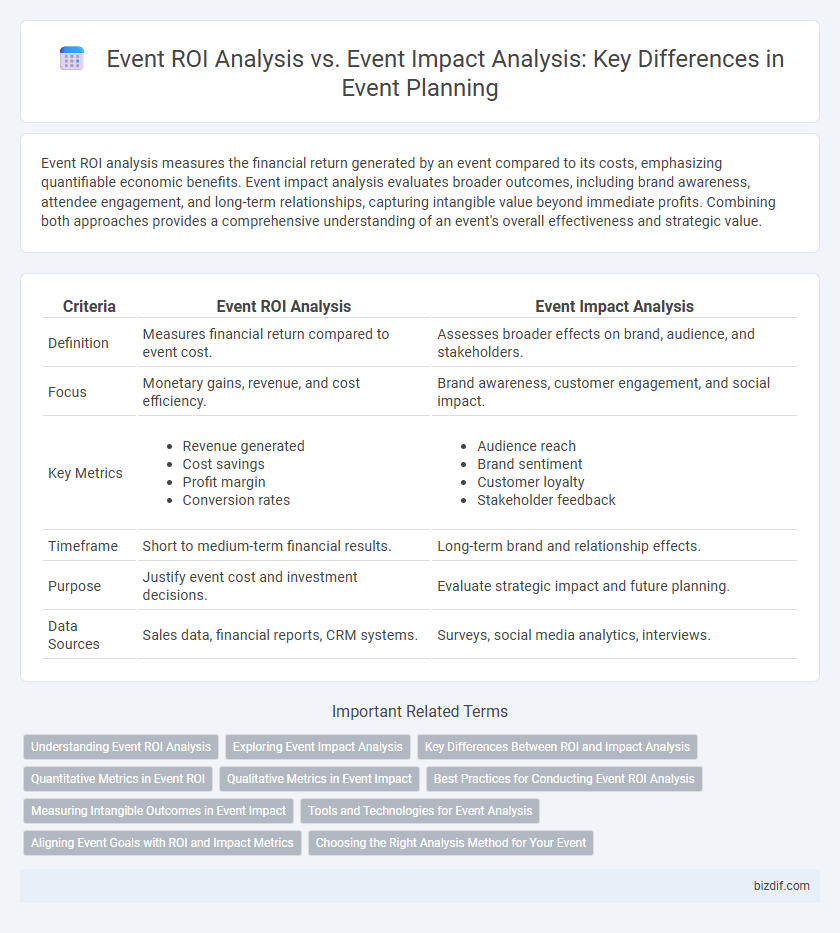Event ROI analysis measures the financial return generated by an event compared to its costs, emphasizing quantifiable economic benefits. Event impact analysis evaluates broader outcomes, including brand awareness, attendee engagement, and long-term relationships, capturing intangible value beyond immediate profits. Combining both approaches provides a comprehensive understanding of an event's overall effectiveness and strategic value.
Table of Comparison
| Criteria | Event ROI Analysis | Event Impact Analysis |
|---|---|---|
| Definition | Measures financial return compared to event cost. | Assesses broader effects on brand, audience, and stakeholders. |
| Focus | Monetary gains, revenue, and cost efficiency. | Brand awareness, customer engagement, and social impact. |
| Key Metrics |
|
|
| Timeframe | Short to medium-term financial results. | Long-term brand and relationship effects. |
| Purpose | Justify event cost and investment decisions. | Evaluate strategic impact and future planning. |
| Data Sources | Sales data, financial reports, CRM systems. | Surveys, social media analytics, interviews. |
Understanding Event ROI Analysis
Event ROI analysis quantifies the financial returns generated from an event relative to its costs, focusing on measurable metrics like revenue, leads, and attendee engagement. This approach enables businesses to assess profitability and justify event budgets by linking outcomes directly to investment. Understanding Event ROI Analysis is crucial for optimizing marketing strategies and maximizing resource allocation in future event planning.
Exploring Event Impact Analysis
Event impact analysis evaluates qualitative and long-term effects on brand perception, customer loyalty, and market positioning, offering insights beyond financial metrics tracked in ROI analysis. It involves measuring attendee engagement, social media reach, and post-event behavior to understand the broader influence on business goals. Incorporating sentiment analysis and stakeholder feedback provides a comprehensive view of an event's strategic value and effectiveness.
Key Differences Between ROI and Impact Analysis
Event ROI analysis measures the financial returns from an event by comparing net profits to the initial investment, emphasizing quantifiable monetary outcomes. In contrast, event impact analysis evaluates broader effects such as brand awareness, audience engagement, and long-term reputation, capturing qualitative and intangible benefits. Key differences lie in ROI's focus on direct economic value versus impact analysis's emphasis on overall influence and strategic objectives beyond immediate financial gains.
Quantitative Metrics in Event ROI
Event ROI analysis centers on quantitative metrics such as cost per lead, conversion rates, and revenue generated, providing a clear financial return from event investments. In contrast, event impact analysis evaluates broader outcomes like brand awareness and attendee engagement, which are often qualitative and harder to measure numerically. Companies prioritizing budget optimization rely on precise ROI calculations to justify event expenditures through tangible financial performance indicators.
Qualitative Metrics in Event Impact
Event ROI analysis primarily measures financial returns through quantitative data such as revenue, ticket sales, and conversion rates, providing a clear numerical assessment of success. In contrast, event impact analysis emphasizes qualitative metrics like attendee satisfaction, brand sentiment, and community engagement, capturing the deeper, long-term effects on stakeholder relationships and brand loyalty. Measuring qualitative outcomes offers insights into emotional resonance, network building, and social influence, essential for understanding an event's true value beyond immediate financial returns.
Best Practices for Conducting Event ROI Analysis
Accurate Event ROI analysis entails tracking measurable financial metrics such as revenue generated, cost savings, and attendee conversion rates to quantify event profitability. Leveraging real-time data collection tools and attendee feedback surveys enhances the precision of outcome measurement. Integrating qualitative impact insights with quantitative ROI metrics provides a comprehensive perspective for optimizing future event strategies.
Measuring Intangible Outcomes in Event Impact
Event ROI analysis primarily measures tangible financial returns such as revenue generated and cost savings, while event impact analysis extends to intangible outcomes including brand awareness, attendee satisfaction, and social influence. Measuring intangible outcomes requires qualitative data collection methods like surveys, interviews, and social media sentiment analysis to capture the emotional and behavioral effects of the event. Focusing on these metrics provides a comprehensive understanding of an event's overall success beyond immediate financial gains.
Tools and Technologies for Event Analysis
Event ROI analysis primarily utilizes financial tracking software, attendee engagement metrics, and CRM systems to quantify monetary returns and cost efficiencies. Event impact analysis leverages social media analytics, sentiment analysis tools, and post-event surveys to evaluate brand awareness, audience sentiment, and long-term influence. Advanced platforms combine AI-driven data integration and visualization technologies to provide comprehensive insights across both ROI and impact dimensions.
Aligning Event Goals with ROI and Impact Metrics
Event ROI analysis quantifies financial returns by measuring revenue generated against event costs, crucial for assessing profitability and justifying budgets. Event impact analysis evaluates broader outcomes such as brand awareness, attendee engagement, and long-term relationship building, offering insights into strategic value beyond immediate financial gains. Aligning event goals with specific ROI and impact metrics ensures comprehensive evaluation, optimizing both immediate returns and sustained organizational benefits.
Choosing the Right Analysis Method for Your Event
Event ROI analysis quantifies financial returns by comparing investment costs to measurable revenue generated, providing clear metrics on profitability and budget efficiency. Event impact analysis assesses broader outcomes such as brand awareness, attendee engagement, and long-term customer loyalty, capturing qualitative effects beyond immediate financial gain. Selecting the appropriate analysis method depends on event objectives, with ROI analysis suited for revenue-driven goals and impact analysis ideal for evaluating intangible benefits and strategic brand positioning.
Event ROI analysis vs Event impact analysis Infographic

 bizdif.com
bizdif.com